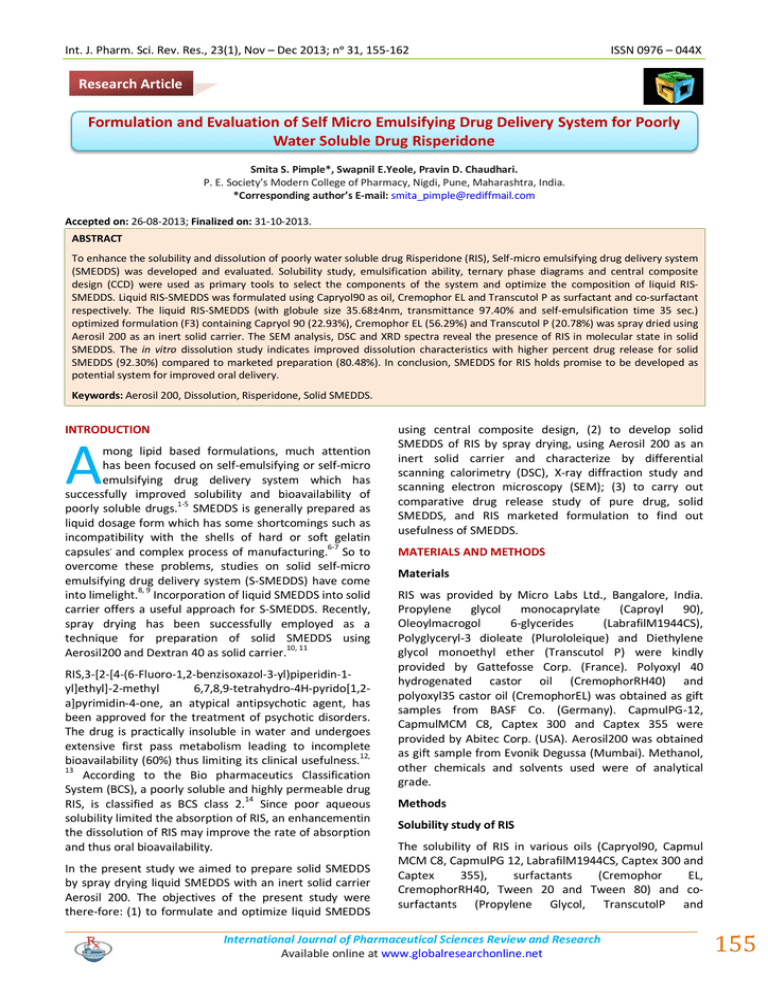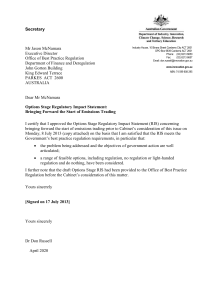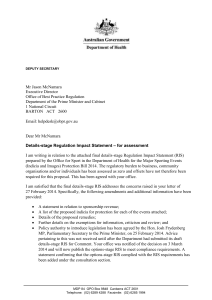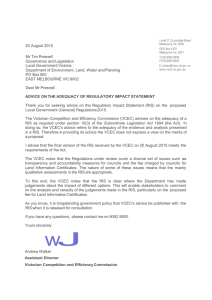Document 13309402
advertisement

Int. J. Pharm. Sci. Rev. Res., 23(1), Nov – Dec 2013; nᵒ 31, 155-162 ISSN 0976 – 044X Research Article Formulation and Evaluation of Self Micro Emulsifying Drug Delivery System for Poorly Water Soluble Drug Risperidone Smita S. Pimple*, Swapnil E.Yeole, Pravin D. Chaudhari. P. E. Society’s Modern College of Pharmacy, Nigdi, Pune, Maharashtra, India. *Corresponding author’s E-mail: smita_pimple@rediffmail.com Accepted on: 26-08-2013; Finalized on: 31-10-2013. ABSTRACT To enhance the solubility and dissolution of poorly water soluble drug Risperidone (RIS), Self-micro emulsifying drug delivery system (SMEDDS) was developed and evaluated. Solubility study, emulsification ability, ternary phase diagrams and central composite design (CCD) were used as primary tools to select the components of the system and optimize the composition of liquid RISSMEDDS. Liquid RIS-SMEDDS was formulated using Capryol90 as oil, Cremophor EL and Transcutol P as surfactant and co-surfactant respectively. The liquid RIS-SMEDDS (with globule size 35.68±4nm, transmittance 97.40% and self-emulsification time 35 sec.) optimized formulation (F3) containing Capryol 90 (22.93%), Cremophor EL (56.29%) and Transcutol P (20.78%) was spray dried using Aerosil 200 as an inert solid carrier. The SEM analysis, DSC and XRD spectra reveal the presence of RIS in molecular state in solid SMEDDS. The in vitro dissolution study indicates improved dissolution characteristics with higher percent drug release for solid SMEDDS (92.30%) compared to marketed preparation (80.48%). In conclusion, SMEDDS for RIS holds promise to be developed as potential system for improved oral delivery. Keywords: Aerosil 200, Dissolution, Risperidone, Solid SMEDDS. INTRODUCTION A mong lipid based formulations, much attention has been focused on self-emulsifying or self-micro emulsifying drug delivery system which has successfully improved solubility and bioavailability of poorly soluble drugs.1-5 SMEDDS is generally prepared as liquid dosage form which has some shortcomings such as incompatibility with the shells of hard or soft gelatin capsules, and complex process of manufacturing.6-7 So to overcome these problems, studies on solid self-micro emulsifying drug delivery system (S-SMEDDS) have come into limelight.8, 9 Incorporation of liquid SMEDDS into solid carrier offers a useful approach for S-SMEDDS. Recently, spray drying has been successfully employed as a technique for preparation of solid SMEDDS using 10, 11 Aerosil200 and Dextran 40 as solid carrier. RIS,3-[2-[4-(6-Fluoro-1,2-benzisoxazol-3-yl)piperidin-1yl]ethyl]-2-methyl 6,7,8,9-tetrahydro-4H-pyrido[1,2a]pyrimidin-4-one, an atypical antipsychotic agent, has been approved for the treatment of psychotic disorders. The drug is practically insoluble in water and undergoes extensive first pass metabolism leading to incomplete 12, bioavailability (60%) thus limiting its clinical usefulness. 13 According to the Bio pharmaceutics Classification System (BCS), a poorly soluble and highly permeable drug RIS, is classified as BCS class 2.14 Since poor aqueous solubility limited the absorption of RIS, an enhancementin the dissolution of RIS may improve the rate of absorption and thus oral bioavailability. In the present study we aimed to prepare solid SMEDDS by spray drying liquid SMEDDS with an inert solid carrier Aerosil 200. The objectives of the present study were there-fore: (1) to formulate and optimize liquid SMEDDS using central composite design, (2) to develop solid SMEDDS of RIS by spray drying, using Aerosil 200 as an inert solid carrier and characterize by differential scanning calorimetry (DSC), X-ray diffraction study and scanning electron microscopy (SEM); (3) to carry out comparative drug release study of pure drug, solid SMEDDS, and RIS marketed formulation to find out usefulness of SMEDDS. MATERIALS AND METHODS Materials RIS was provided by Micro Labs Ltd., Bangalore, India. Propylene glycol monocaprylate (Caproyl 90), Oleoylmacrogol 6-glycerides (LabrafilM1944CS), Polyglyceryl-3 dioleate (Plurololeique) and Diethylene glycol monoethyl ether (Transcutol P) were kindly provided by Gattefosse Corp. (France). Polyoxyl 40 hydrogenated castor oil (CremophorRH40) and polyoxyl35 castor oil (CremophorEL) was obtained as gift samples from BASF Co. (Germany). CapmulPG-12, CapmulMCM C8, Captex 300 and Captex 355 were provided by Abitec Corp. (USA). Aerosil200 was obtained as gift sample from Evonik Degussa (Mumbai). Methanol, other chemicals and solvents used were of analytical grade. Methods Solubility study of RIS The solubility of RIS in various oils (Capryol90, Capmul MCM C8, CapmulPG 12, LabrafilM1944CS, Captex 300 and Captex 355), surfactants (Cremophor EL, CremophorRH40, Tween 20 and Tween 80) and cosurfactants (Propylene Glycol, TranscutolP and International Journal of Pharmaceutical Sciences Review and Research Available online at www.globalresearchonline.net 155 Int. J. Pharm. Sci. Rev. Res., 23(1), Nov – Dec 2013; nᵒ 31, 155-162 Plurololeique) was determined by adding excess amount of RIS in 1 ml of each vehicle placed in screw capped glass vial. The ingredients were mixed using a magnetic stirrer and then kept on orbital shaker (Remi motors & RIS-24BL) 0 for 72 h at temperature 37±1.0 C. The samples were then centrifuged at 10,000 rpm for 5 min at 370C. The supernatant was then diluted with methanol and quantified by UV spectrophotometer (Shimadzu, Japan) at 279.4 nm. Screening of surfactant From the pool of surfactants for oral use, screening for emulsification ability was carried out. Briefly, Addition of Surfactant to the oily phase was done in equal ratio. The mixtures were gently heated at 40°C for homogenization of the components. Emulsification ability was judged by flask inversion method on diluting mixtures with distilled water to form homogenous and transparent emulsion. Then emulsions were kept at room temperature for 2hr; and evaluated for % transmittance at 638.2nm by UVspectrophotometer (Shimadzu, Japan) using distilled water as a blank. A visual observation for any turbidity or phase separation was carried out to check its physical appearance and stability.15,16 Screening of co-surfactant Various co-surfactants (transcutol P, propylene glycol, polyethylene glycol and plurololeique) with the selected oily phase and surfactant were screened for their emulsification ability. Mixtures of 100 mg of cosurfactant, 200 mg of selected surfactant and 300 mg of selected oil phase were prepared and evaluated in a similar manner as that for surfactant. Drug-excipient compatibility The FTIR spectra of pure RIS, physical mixture containing drug and oily excipients; and solid SMEDDS were recorded using Fourier transform infra-red spectrophotometer (FTIR4100 Jasco, Japan) with diffuse reflectance principle. The spectrum was scanned over a frequency range 4000 – 400 cm-1. The resultant spectra were compared for any spectral changes. Construction of pseudo-ternary phase diagram The pseudo-ternary phase diagrams were constructed to determine micro emulsifying region by titrating homogenous liquid mixtures of oil (Capryol90), surfactant (Cremophor EL) and cosurfactant (TranscutolP) with water phase, at room temperature. A series of formulations were prepared using oil : surfactant ratios (1:9, 2:8, 3:7, 4:6, 5:5, 6:4, 7:3, 8:2, 9:1) with varying surfactant : co-surfactant ratios (Km) of (1:1, 2:1, 3:1 and 4:1). The total amount of oil and surfactant: co-surfactant was kept 100%. The components were mixed with magnetic stirrer for 30 min at 400C and mix was stored overnight at room temperature allowing the system to reach equilibrium. During water titration, samples were stirred to allow equilibration. At the same time, samples were visually examined for transparency. Only ISSN 0976 – 044X homogeneous, transparent, low viscosity mixtures were considered as micro emulsions. The data obtained was subjected to CHEMIX software for construction of ternary plot. Formulation and optimization using Central composite design (CCD) Central composite design (CCD) is Response surface methodology (RSM) experimental design suitable for formulation and optimization of SMEDDS. 16 CCD determines the influence of the selected variables on the subject responses. RIS loaded SMEDDS was formulated by simply mixing the RIS (2%w/w), with Capryol 90, Cremophor EL and Transcutol P with gentle stirring at room temperature to dissolve properly and observed for clarity. Central composite design (CCD) was used to optimize the formulation of RIS-loaded SMEDDS. Based on the previous preliminary experimental studies, two formulation parameters, the oil percentage and surfactant/ co-surfactant ratio, were identified as important factors responsible for the characteristics of SMEDDS. The concentration ranges of these two factors were determined on the basis of feasibility of SMEDDS formation. So the values were as, oil percentage (X1): 20%-40%; surfactant/co-surfactant ratio (X2): 1–3. Globule size (Y1), % transmittance (Y2) and selfemulsification time (Y3) are selected as the response factors for assessing the quality of SMEDDS. A two-factor, five-level CCD was implemented to find out the main effects as well as the interactions of the two independent variables on three responses under study.The parameters, oil percentage and surfactant/co-surfactant ratio, were varied as mentioned in Table 1. The data obtained for three responses were fitted using Design expert software 7.1.3 to second order polynomial model, represented as follows: Y= b0 + b1X1 + b2X2 + b3X11+ b4X22 + b5X1X2 (1) Where Y corresponds to predicted response, X1 and X2 correspond to the studied factors, b0 is an intercept, and b1–b5 is regression coefficient.F-test was applied to evaluate lack of fit within each model to identify best fitting model. The response surface graphs were plotted for three responses. Liquid SMEDDS characterization % transmittance The clarity of the formulations was observed by measuring % Transmittance of all formulations at 638.2nm in UV spectrophotometer using double distilled water as blank. Globule size analysis The globule size determination was performed using photon cross correlation spectroscopy (Nanophox, Sympatec, Germany). Emulsion (50µL) was diluted with the 5mL oil provided with the sample. Sample was placed in polystyrene cuvette (path length 1cm each) which was International Journal of Pharmaceutical Sciences Review and Research Available online at www.globalresearchonline.net 156 Int. J. Pharm. Sci. Rev. Res., 23(1), Nov – Dec 2013; nᵒ 31, 155-162 ISSN 0976 – 044X placed in thermostatic sample chamber maintained at 250C and 3 runs, for 60sec were performed. Detection was carried out at scattering angle of 900. From resulting correlation curves, second order equation was applied to obtain the mean globule size. rpm. Emulsification time was assessed visually and categorized into grades such as; rapidly forming microemulsion in <1 minute with clear or slightly bluish in appearance (Grade I),rapidly forming emulsion in <2 minute having lesser clarity with bluish white appearance (Grade II), Bright white emulsion formation in <2 minute Determination of Self emulsification time with milky appearance (Grade III), Dull and grayish white The assessment of formulations was done by adding1 ml emulsion formation with slight oily appearance in >3 of each formulation to standard dissolution apparatus minute (Grade IV), and emulsions formed in >3 minute (USP Type II) containing 100 ml purified water at 370C., with large oil globule having poor emulsification ability gentle agitation was provided by paddle rotating at 50 (Grade V). Table 1: Factor level and the correspondent values Name Units -alpha -1 Level 0 level +1 level +alpha Oil % 20 22.9289 30 37.0711 40 Surfactant: Co-surfactant Ratio 1 1.29289 2 2.70711 3 Solid SMEDDS preparation In vitro dissolution study Optimum L-SMEDDS formulation was selected and further converted to S-SMEDDS powder by spray drying. A 1% w/v suspension of Aerosil200 in methanol was prepared. To it, one ml of L-SMEDDS containing RIS (1.98% w/w) was added, with constant stirring, and homogenous suspension was obtained by stirring the above mixture at room temperature. This resultant mixture was then spray dried using laboratory spray drier (labultima). The experimental conditions were as follows: inlet temperature of 70-750C, outlet temperature of 50550C, and aspiration of about 45%. The feeding rate of the suspension was set to 5 ml/min. RIS S-SMEDDS formulation was filled in capsule. The quantitative in vitro release test was performed in 500 mL (0.1N HCl) maintained at 37 ± 0.5°C using USP type II dissolution apparatus. The paddles were rotated at 50 rpm. Five ml aliquots was collected periodically (5, 10, 15, 30, 45, 60, min) and replaced with fresh dissolution medium. Aliquots, after filtration through whatman filter paper and diluted with methanol. Analysis was carried out using UV spectrophotometer at 279 nm. Results were compared with marketed RIS tablet and pure RIS.The dissolution experiments were carried out in triplicate, and data were expressed as mean ± S.D. Solid SMEDDS Characterization Table 2: Solubility of RIS in various oils, surfactants and co-surfactants (mean ± SD, n = 3) Morphological analysis of solid SMEDDS The surface morphology of the solid SMEDDS was studied by scanning electron microscopy (SEM). The samples for SEM were prepared by lightly sprinkling powder on a double adhesive tape stuck to an aluminum stub which was then placed in the scanning electron microscope (JEOL JSM- 6360, Japan) chamber. The samples were then randomly scanned and photomicrographs were taken and the SEM results were obtained. Differential scanning calorimetry (DSC) The DSC thermograms were recorded for drug and SSMEDDS using differential scanning calorimeter (TA-60 WS thermal analyzer, Schimadzu, Japan). Approximately 2-5 mg of each sample was heated in aluminum pan (Al0 0 Crucibles, 40 Al) from 30 C to 300 C at a heating rate of 0 10 C/min under a stream of nitrogen at flow rate of 50ml/min. X-ray diffraction studies (XRD) X-ray diffraction patterns of the powdered samples of the drug and formulation were scanned by Brucker D 8 Advanced X-ray diffractometer from diffraction angle (2θ) 5 to 500. Diffraction pattern for RIS and S-SMEDDS were obtained. Excipients Capryol 90 Capmul MCM C8 Labrafill M1944CS Capmul PG12 Solubility (mg/ml) 77.63 ± 0.23 31.15 ± 0.84 19.32 ± 0.54 44.59 ± 1.23 Captex 300 Captex 355 Tween 20 Tween 80 Cremophor EL Cremophor RH 40 5.07 ± 0.25 3.73 ± 0.23 66.88 ± 0.19 171.72 ± 0.04 187.84 ± 0.52 74.94 ± 0.08 Transcutol P Plurololeique Propylene glycol 52.92 ± 0.09 30.07 ± 0.52 10.98 ± 0.04 RESULTS AND DISCUSSION Solubility study Self microemulsifying system consists of oils, surfactants ant co-surfactants mixed with the drug. While developing such system, precipitation of drug should not occur. The system has to be clear and monophasic when administered into GI lumen. Therefore the components used in the system should have high solubilization International Journal of Pharmaceutical Sciences Review and Research Available online at www.globalresearchonline.net 157 Int. J. Pharm. Sci. Rev. Res., 23(1), Nov – Dec 2013; nᵒ 31, 155-162 capacity for the drug. The solubility of RIS in various oils, surfactants and co-surfactants is presented in Table 2. Different oils were screened for RIS solubility study. Among these Capryol 90 (77.63mg/ml) was selected as final oil component of the formulation on the basis of highest solubility and emulsification ability with other ingredients. Screening of surfactants and co surfactants for emulsifying ability From the number of surfactants available for formulation, nonionic surfactants were considered to be safe for oral ISSN 0976 – 044X use. Amongst various nonionic surfactants, selection was carried out on the basis of ease of emulsification and higher transmittance. The results showed that Cremophor EL has higher % transmittance (99.42%) and lesser number of flask inversions (4) as compared to Cremophor RH40, Tween 20 and Tween 80 (Table 3). In case of the co-surfactants screening, Transcutol P showed 98.21 % transmittance and 5 flask inversion which revealed better result when compared to plurololeique (Table 3). Thus Cremophor EL was selected as the surfactant and Transcutol P as co-surfactant respectively. Table 3: % Transmittance and number of flask inversion values of different mixtures (mean ± SD, n = 3) Screening of Surfactant Oil Capryol 90 Capmul MCM C8 Capmul PG12 Labrafil M1944CS Cremophor EL 91.23±1.23 (10*) 99.42± 0.19 (4*) 97.37± 1.20 (6*) 91.15± 1.40 (13*) Tween 20 83.22±2.29 (20*) 96.34± 1.35 (15*) 96.34± 0.49 (25*) 45.90± 1.80 (28*) Tween 80 88.81±0.39 (8*) 98.79± 0.18 (5*) 97.54± 0.26 (5*) 39.08± 1.18 (15*) Surfactant Screening of Co-surfactant Oil/Surfactant Capryol 90 / Cremophor EL Co-surfactant Plurololeique Transcutol P *No. of flask inversion. Capmul PG 12 / Cremophor EL 51.20±0.46 (22*) 55.20±2.70 (20*) 98.21± 0.76 (5*) 51.22±0.87 (18*) Table 4: Experimental runs with results of response Formulation code Oil % X1 Km X2 Globule size(nm) Y1 % transmittance Y2 Emulsification time (sec) Y3 F1 22.93 1.29 80.4 96.80 42 F2 37.07 1.29 171.53 82.11 90 F3 22.93 2.71 30.75 97.40 35 F4 37.07 2.71 176.27 85.35 40 F5 20 2 51.24 99.80 38 F6 40 2 190.11 81.17 100 F7 30 1 167.24 89.90 45 F8 30 3 120.24 93.20 50 F9 30 2 131.63 91.40 53 F10 30 2 133.30 90.80 55 F11 30 2 132.40 91.30 54 F12 30 2 134.64 92.00 58 F13 30 2 132.87 91.70 60 Pseudo ternary phase diagram Pseudo-ternary phase diagrams were constructed (Figure 1 A-D) with different surfactant/co-surfactant ratio of 1:1, 2:1, 3:1 and 4:1, to determine the micro emulsifying region and to determine concentration of oil, surfactant and co-surfactant for development of SMEDDS. Wider region indicates better self-micro emulsifying ability. It was observed that surfactant concentration less than 60% resulted in formation of turbid and crude emulsions (data not shown). It was found that the formulations with 2040% oil and 60-80% surfactant mixture have shown higher transparency and greater stability and higher self micro emulsifying region. From this study the oil percentage (20-40%) and surfactant/ co-surfactant ratio (1:1, 1:2, 1:3) were considered as extreme values for the feasibility of SMEDDS formation. International Journal of Pharmaceutical Sciences Review and Research Available online at www.globalresearchonline.net 158 Int. J. Pharm. Sci. Rev. Res., 23(1), Nov – Dec 2013; nᵒ 31, 155-162 ISSN 0976 – 044X 2 YGS = – 75.24 + 14.83 X1 – 109.42 X2 + 2.72 X1 X2 – 0.21 X1 + 2.03 X22………………………. (2) YT = +112.43 – 0.45 X1 – 1.69 X2 + 0.13 X1 X2 – 0.012 X12 – 2 0.191 X2 ……………………….. (3) YSET = – 89.205 + 0.936X1 + 102.673X2 – 2.15X1 X2 + 0.0975X12 – 11.75X22……… (4) Figure 1: Pseudo ternary phase diagram for Km ratios A) 1:1, B) 2:1 C) 3:1 and D) 4:1 Drug-excipient compatibility study by FT-IR DSC is not only studying tool to demonstrate an effective drug interaction, but non thermal tool Fourier-transform infrared spectroscopy (FTIR) can also be used. FT-IR analysis of pure RIS, physical mixture and solid SMEDDS was carried out to identify potential interaction between RIS and formulation components as well as adsorbent (Figure 2 A-C). The following characteristic peaks were observed for pure RIS: 3070 cm-1 (Aromatic CH- stretch) 2864 and 2939cm-1 (aliphatic C-H stretching), 1120 cm-1 (C-F stretch), 1534 cm-1(C=N stretching), and 1733 cm-1 (Aromatic C=0 stretch). The presence of prominent peaks of pure RIS in thermograms of physical mixture and as well as in selected solid SMEDDS reveals the compatibility between drug, excipients and carrier. For assessment of SMEDDS, globule size plays critical role. The smaller globule size provides a larger interfacial surface area for drug absorption and also permits a faster release rate. The positive coefficient with higher value for X1 in equation (3) shows us that concentration of oil has higher influence on the globule size than surfactant/cosurfactant concentration. The results in response surface Figure 4A showed that the globule size decreased either with reducing oil percentage or increased ratio of surfactant/co-surfactant. Transmittance of SMEDDS is another important response variable which represents the whether the system was monophasic or not on the basis of clarity of system. The negative coefficient with higher value for X1 shows us that concentration of oil has higher influence on the transmittance than surfactant/co-surfactant concentration. Negative coefficients show us the inverse relation between the formulation factors and response variables. The results in response surface Figure 4B showed that the transmittance increased with decreased oil%. Time required for emulsification generally related to the release characteristics of drug delivery system. Therefore self-emulsification time of SMEDDS was considered as basic response variable which contributed to its assessment. The results in equation (3) and in response surface Figure 4C showed that the self-micro emulsifying time (SET) increased either with the increase in the percent of oil or surfactant: co-surfactant ratio which is correlated to the change in viscosity as well as emulsification ability of the system. Table 5: ANOVA and Model adequacy determination ANOVA results of the measured responses (Y) Figure 2: FT-IR spectra of (A) pure RIS, (B) physical mixture containing capryol 90, cremophor EL, transcutol P and (C) RIS S-SMEDDS. ANOVA Formulation and optimization using Central composite design (CCD) The experimental results of CCD are reported in Table 4. All the data were computed by design expert software (Version 7.1.3). The three responses were fitted to quadratic second-order polynomial model. The model, which shown a lesser P value (≤0.05) and greater F value (Table 5)was identified as the fitting model. This finding has supported that the formulationfactors had significant effect on the responses. The polynomial equation obtained for response globule size (GS), % transmittance (T) and Self emulsification time (SET) was as follows: Coefficient Y1 Y2 Y3 F value 42.41 311.743 6.674 P value < 0.0001 <0.0001 0.013 Model adequacy prediction Predicted Experimental Bias* (%) Globule size(nm) 41.82 32.80 27.50 Transmittance (%) 97.75 98.5 -0.76 Selfemulsification 41.92 39.4 time (sec) *Bias – Predicted-experimental/Predicted International Journal of Pharmaceutical Sciences Review and Research Available online at www.globalresearchonline.net 6.39 159 Int. J. Pharm. Sci. Rev. Res., 23(1), Nov – Dec 2013; nᵒ 31, 155-162 The design reported that a decrease in oil percentage resulted into decrease of globule size, an increase in transmittance and a decrease in self-emulsification time, which would help to improve solubility. Thus, formulation (F3) having globule size 35.68nm, transmittance 97.40% and self-emulsification time 35 sec. was found to be optimized though it has transmittance 97.40% (range for F1 to F13 - 81-99%). The composition of optimized formulation (F3) of liquid SMEDDS of RIS was found to be ISSN 0976 – 044X Capryol 90 (22.93%), Cremophor EL of (56.29%) and Transcutol P (20.78%.) Adequacy of model was confirmed for prediction by formulating optimized batch of SMEDDS and evaluating the responses. The results are represented in Table 5. Since a reasonable agreement existed between the predicted and observed results, the model was proven to be validated. Figure 3: Response surface diagrams for A) Globule size, B) Transmittance and C) Self-emulsification time as a function of oil% and Km ratio. Figure 4: Globule size determinations (F3) Figure 5: Solid state characterization of S-SMEDDS by A) SEM, B) DSC and C) XRD study International Journal of Pharmaceutical Sciences Review and Research Available online at www.globalresearchonline.net 160 Int. J. Pharm. Sci. Rev. Res., 23(1), Nov – Dec 2013; nᵒ 31, 155-162 Characterization of liquid SMEDDS % Transmittance The selected formulations were evaluated for its transparency and the results are shown in Table 4. From the results obtained, formulation F3 showed 97.40% transmittance while others showed in the range of 8199%. Globule size determination The globule size was found to less than 100nm for most of the tested formulation (Table 4). Mean globule size of formulation F3 was 30.75nmwith poly dispersitivity index 0.3469 (Figure 4). ISSN 0976 – 044X Spray drying was found to be useful solidification technique which produced uniform and free flowing particles of S-SMEDDS. The SEM analysis, DSC measurements and X-ray diffraction analysis suggested that RIS is present in the dissolved state in solid SMEDDS. In vitro dissolution test showed that the solid SMEDDS had a higher in vitro release rate than the drug powder and marketed formulation. A significant improvement in dissolution is obtained for the drug. Hence, SMEDDS for RIS holds promise to be developed as useful oral solid dosage form. Determination of self-emulsification time The lowest self-emulsification time was observed for formulation F3 (35 sec) and rest of the formulations showed in the range of 35 sec to 100 sec (Table 4). Solid state characterization of S-SMEDDS The scanning electron micrographs of the RIS S-SMEDDS prepared with aerosil 200 appeared as spherical smoothsurfaced particles [Figure 5 A (c)] compared to that of aerosil 200 [Figure 5A(b)] which are rough in nature. This observation indicates that the crystalline drug powder [Figure 5A (a)] is converted into amorphous form or drug must be present in dissolved state in S-SMEDDS. The DSC curves of pure RIS and S-SMEDDS formulations are shown in Figure 5B. Pure RIS showed sharp endothermic peak at temperature 1720C, corresponding to its melting point and indicating its crystalline nature showing melting has occurred at that temperature. However, our result shows the disappearance of endothermic peak of the drug in the S-SMEDDS supports the presence of RIS in an amorphous form in S-SMEDDS. X-ray diffraction patterns (Figure 5C) supported the presence of RIS in amorphous state in SSMEDDS. RIS had sharp peaks at the diffraction angles, showing a typical crystalline pattern and the disappearance of sharp peaks in RIS S-SMEDDS indicates presence of RIS in an amorphous state.17,18 Figure 6: In vitro drug release profile comparison REFERENCES 1. Patel D, Sawant KK, Oral bioavailability enhancement of acyclovir by self-microemulsifying drug delivery systems (SMEDDS), Drug Development and Industrial Pharmacy, 33, 2007, 1318-1326. 2. Wu X, Xu J, Huang X, Wen C, Self-microemulsifying drug delivery system improves curcumin dissolution and bioavailability, Drug Development and Industrial Pharmacy, 37, 2011, 15-23. 3. Kang BK, Lee JS, Chon SK, Jeong SY, Yuk SH, Khang G, Lee HB, Cho SH, Development of self-micro emulsifying drug delivery systems (SMEDDS) for oral bioavailability enhancement of simvastatin in beagle dogs, International Journal of Pharmaceutics, 274, 2004, 65–73. 4. Wu W, Wang Y, Que L, Enhanced bioavailability of silymarin by self-microemulsifying drug delivery system, European Journal of Pharmaceutics and Biopharmaceutics, 63, 2006, 288–294. 5. Humberstone AJ, Charman WN, Lipid-based vehicles for the oral delivery of poorly water soluble drugs, Advance Drug Delivery Review, 25, 1997, 103–128. 6. Pather SI, Gupte SV, Khankari J, Hontz K, Robinson JR, Eichman JD, Kumbale R, Microemulsions as solid dosage forms for oral administration, US Patent, 6, 280, 2001,770 B1. 7. Nazzal S, Wang Y, Characterization of soft gelatin capsules by thermal analysis, International Journal of Pharmaceutics, 230, 2001, 35–45. 8. Cannon JB, Oral solid dosage forms of lipid-based drug delivery systems, American Pharmaceutical Review, 8, 2005, 108–115. In vitro dissolution study An in vitro release study was carried out to understand the characteristics of drug release from SMEDDS. As shown in Figure 6, the release performance of RIS from SSMEDDS formulations was significantly improved, compared with the conventional tablets and pure drug powder. The solid SMEDDS (92.30%) of RIS has shown higher % drug release over 1hr when compared to the marketed tablet formulation (80.48%) and pure drug powder (54.60%).19 CONCLUSION In this study, the solid SMEDDS of RIS was successfully formulated in an attempt to increase its solubility and dissolution rate. The pseudo ternary phase diagram and central composite design (CCD) were successfully employed as optimization tool to optimize L-SMEDDS. International Journal of Pharmaceutical Sciences Review and Research Available online at www.globalresearchonline.net 161 Int. J. Pharm. Sci. Rev. Res., 23(1), Nov – Dec 2013; nᵒ 31, 155-162 9. Tang B, Cheng G, Gu JC, Xu CH, Development of solid selfemulsifying drug delivery systems: Preparation techniques and dosage forms, Drug Discovery Today, 13, 2008, 606612. 10. Tao Y, Jiangling W, Huibi X, Xiangliang Y, A new solid selfmicro emulsifying formulation prepared by spray-drying to improve the oral bioavailability of poorly water soluble drugs, European Journal of Pharmaceutics and Biopharmaceutics, 70, 2008, 439–444. 11. Balakrishnan P, Lee B, Oh DH, Kim JO, Hong MJ, Jee J, Kim JA,Yoo BK, Woo JS, Yong CS, Choi H, Enhanced oral bioavailability of dexibuprofen by a novel solid Selfemulsifying drug delivery system (SEDDS), European Journal of Pharmaceutics and Biopharmaceutics, 72, 2009, 539–545. 12. http://www.uspbpep.com/ usp31nf26s1_m73740/USP Monographs/Risperidone.htm 13. Jann MW, Risperidone Pharmacotherapy, 11, 3, 1999, 179195. 14. Lindenberg M, Kopp S, Dressman JB, Classification of orally administered drugs on the world health organization model list of essential medicines according to the biopharmaceutics classification system, European Journal ISSN 0976 – 044X of Pharmaceutics and Biopharmaceutics, 58, 2, 2004, 265– 278. 15. Date AA, Nagarsenker MS, Design and evaluation of selfnanoemulsifying drug delivery systems (SNEDDS) for cefpodoxime proxetil, International Journal of Pharmaceutics, 329, 2007, 166-172. 16. Cui S, Nie S, Li L, Wang C, Pan W, Sun J, Preparation and Evaluation of Self-Microemulsifying Drug Delivery System Containing Vinpocetine, Drug Development and Industrial Pharmacy, 35, 5, 2009, 603-611. 17. Liu Y, Chen ZQ, Zhang X, Feng N, An improved formulation screening and optimization method applied to the development of a self-micro emulsifying drug delivery system, Chemical and Pharmaceutical Bulletin, 58, 1, 2010, 16-22. 18. Mladen M, Jelena D, Ljiljana D, Dragana V, Svetlana I: Characterization and evaluation of solid selfmicroemulsifying drug delivery systems with porous carriers as systems for improved carbamazepine release, International Journal of Pharmaceutics, 436, 2012, 58–65. 19. http://www.uspbpep.com/usp31nf26s1_m73744/USP Monographs/risperidonetablets.htm. Source of Support: Nil, Conflict of Interest: None. International Journal of Pharmaceutical Sciences Review and Research Available online at www.globalresearchonline.net 162




